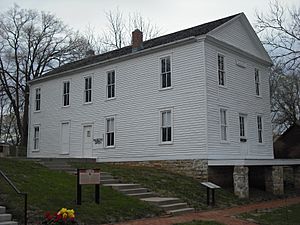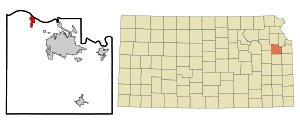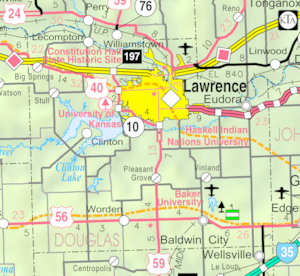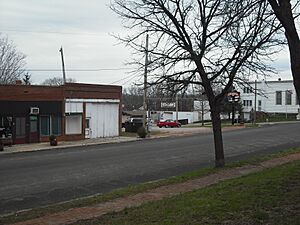Lecompton, Kansas facts for kids
Quick facts for kids
Lecompton, Kansas
|
|
|---|---|

1857 Constitution Hall (2009)
|
|

Location within Douglas County and Kansas
|
|

|
|
| Country | United States |
| State | Kansas |
| County | Douglas |
| Founded | 1854 |
| Incorporated | 1855 |
| Named for | Samuel Dexter Lecompte |
| Area | |
| • Total | 1.76 sq mi (4.57 km2) |
| • Land | 1.76 sq mi (4.55 km2) |
| • Water | 0.01 sq mi (0.02 km2) |
| Elevation | 925 ft (282 m) |
| Population
(2020)
|
|
| • Total | 588 |
| • Density | 334.1/sq mi (128.67/km2) |
| Time zone | UTC-6 (CST) |
| • Summer (DST) | UTC-5 (CDT) |
| ZIP code |
66050
|
| Area code | 785 |
| FIPS code | 20-39150 |
| GNIS ID | 2395667 |
Lecompton (pronounced /lɪˈkɒmptən/) is a city in Douglas County, Kansas, United States. In 2020, the city had 588 people living there. Lecompton is located on the Kansas River. It was the official capital of the Kansas Territory from 1855 to 1861. It was also the main city for Douglas County from 1855 to 1858.
This time was known as Bleeding Kansas. It was a period of fighting between people who wanted slavery in Kansas and those who did not. Lecompton was a strong supporter of slavery during the mid-1800s.
Contents
History of Lecompton
Early Days in the 19th Century
Lecompton was started in 1854. It was built on a high bank on the south side of the Kansas River. The city was first called Bald Eagle. It was later renamed Lecompton to honor Samuel Dexter Lecompte. He was the chief judge of the area's Supreme Court.
In August 1855, Lecompton became the capital of the Kansas Territory. President Franklin Pierce chose it and sent officials to set up government offices there. Lecompton quickly became a center for pro-slavery politics. This caused problems with nearby Lawrence, which was founded by people who opposed slavery.
Lecompton's first post office opened in September 1855. The city was the main government center for Douglas County. But in 1858, this role was moved to Lawrence.
The Lecompton Constitution
In late 1857, a group met in Constitution Hall. They wrote the Lecompton Constitution. This document would have made Kansas a slave state. However, the United States Congress rejected it after a big national debate. This argument was a major topic in the famous Lincoln-Douglas debates. The conflict helped lead to the American Civil War.
The Lecompton Constitution failed partly because people who opposed slavery won control of the local government in 1857. This new government met at Constitution Hall. They quickly began to undo the pro-slavery laws made by the previous government.
For a short time, some people tried to move the capital to Minneola. But the governor stopped this plan. So, Lecompton remained the official capital until Kansas became a state on January 29, 1861. At that time, the anti-slavery leaders chose Topeka as the new state capital. The American Civil War began a few months later, in April 1861.
Education and Historic Buildings
In 1865, a church group called the United Brethren Church started a university in Lecompton. It was first in a hotel building. Later, in 1882, they built a stone building. This building was named "Lane University" after James H. Lane, who opposed slavery. The university brought many students and teachers to the town.
Lane University did well until 1902. Then, it moved and joined with another college. The bell from Lane University is now at Holton High School. The old Lane University building was used as Lecompton's high school for a while. Later, it became old and worn out.
In the 1970s, the community raised money to fix up the building. It is now the Territorial Capital Museum. The Lecompton Historical Society takes care of it. Just two blocks away is Constitution Hall. This is where the famous Lecompton Constitution was written. Constitution Hall is now a museum run by the Kansas Historical Society.
In the 1880s, a church split happened. One group built a new church nearby. They called it the Radical United Brethren Church. This church burned down around 1902. A new stone church was built in its place. The first church building was used as Lecompton City Hall until about 2006. The stone church is now a community building.
In 2016, the Radical United Brethren Church was added to the Kansas Register for Historic Places. Lecompton now has four buildings on historic registers. The others are Constitution Hall, the Democratic Headquarters from the Bleeding Kansas time, and the Lane University building (Territorial Capital Museum).
In 1916, a fire destroyed many wooden businesses on Main Street. They were replaced with brick buildings. A painting in the local post office shows how the city looked before the fire.
20th and 21st Century Changes
In 1998, the Lecompton Historical Society started fixing up the old stone Democratic Headquarters Building from the 1850s. This building was moved to Riverview Park. This park is along the Kansas River.
Around 2015, downtown Lecompton had an antique shop, a cafe, an art shop, and a car repair garage. There was also a convenience store and meat market nearby. The city bought the old Lecompton High School. They started changing it into a community building for everyone to use.
Geography and Climate
Lecompton covers about 1.78 square miles (4.61 square kilometers). Most of this area is land.
The weather in Lecompton has hot, humid summers. Winters are usually mild to cool. This type of weather is called a humid subtropical climate.
Population and People
| Historical population | |||
|---|---|---|---|
| Census | Pop. | %± | |
| 1880 | 284 | — | |
| 1890 | 450 | 58.5% | |
| 1900 | 408 | −9.3% | |
| 1910 | 386 | −5.4% | |
| 1920 | 310 | −19.7% | |
| 1930 | 288 | −7.1% | |
| 1940 | 250 | −13.2% | |
| 1950 | 263 | 5.2% | |
| 1960 | 304 | 15.6% | |
| 1970 | 434 | 42.8% | |
| 1980 | 576 | 32.7% | |
| 1990 | 619 | 7.5% | |
| 2000 | 608 | −1.8% | |
| 2010 | 625 | 2.8% | |
| 2020 | 588 | −5.9% | |
| U.S. Decennial Census | |||
Lecompton is part of the larger Lawrence, Kansas area.
Population in 2020
The 2020 United States census counted 588 people in Lecompton. There were 247 households and 166 families. About 86% of the people were white. About 22% of the population was under 18 years old. The average age was about 40.6 years.
Population in 2010
In 2010, there were 625 people living in Lecompton. There were 240 households. About 95% of the people were White. About 29% of residents were under 18 years old. The average age was 36.7 years.
Education
The Perry–Lecompton USD 343 public school district serves the community. This district was formed in 1970 when schools from Perry and Lecompton joined together. Perry-Lecompton High School is located in Perry. Lecompton Elementary School is in Lecompton. The high school mascot is the Perry-Lecompton Kaws.
Lecompton High School closed in 1970 when the schools combined. Its mascot used to be the Lecompton Owls.
Notable People
- William East - A judge for the United States District Court.
- Robert Stevens - A former member of the U.S. Congress.
- Chuck Wright – He was the Mayor of Topeka, Kansas, from 1965 to 1969.
Images for kids
See also
 In Spanish: Lecompton para niños
In Spanish: Lecompton para niños









